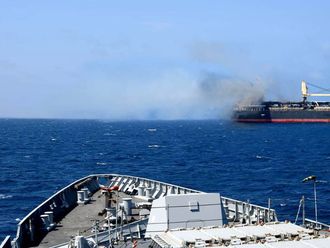Sana’a, Yemen: Yemen’s exiled government on Monday declared three areas in the country engulfed in fighting between Al Houthi militia, their allies and government forces as “disaster” zones, including the southern port city of Aden, and said that the month of violence has claimed 1,000 civilian lives.
The crisis in Yemen, the Arab world’s most impoverished country, has deepened since March 26, when a Saudi-led coalition launched airstrikes aimed at rolling back territorial gains by the Al Houthis and their allies, loyalists of ousted President Ali Abdullah Saleh.
The country’s internationally recognised President Abd Rabbo Mansour Hadi fled last month to Riyadh and his government now operates from the Saudi capital.
On Monday, the government raised the alarm for Aden as well as the cities of Taiz and Dhale, saying there is no electricity or water there and that these cities have run out of fuel, medical supplies and food.
“These cities are on verge of collapse,” said Minister of Communications Nadia Saqqaf.
The three cities have also been the focus of a pressing offensive by the Al Houthis and Saleh’s forces. While they have resisted the rebels’ assault, pro-government forces, consisting mainly of poorly-armed and lightly-equipped militias, have failed to protect civilians caught in the cross-fire.
Saqqaf said nearly a quarter million Yemenis, out of a population of 25 million, have been displaced. On average, 15 people are killed by sniper fire or random shelling daily in Aden, he said.
The exiled government also set the civilian casualty toll for the past month at 1,000 - nearly double the number that UN agencies announced days ago.
Last week, Rupert Colville, a spokesman for the UN High Commissioner for Human Rights, said 551 civilians have been killed and 1,185 wounded in the violence between March 26 and April 22. The total death toll, including both combatants and civilians is 1,080, the UN said.
The deaths, the agency said, resulted from both airstrikes and fighting on the ground. The discrepancies in the casualty figures provided by the exiled government and the UN agencies could not immediately be reconciled.
Another minister in exile, Ezz Al Deen Al Asbahi, said the Al Houthis and Saleh’s forces are turning hospitals, clinics and schools into weapons caches, which makes them target of Saudi-led airstrikes. Al Asbahi, who is the human rights minister, said 9 million Yemenis are in need of some form of medical intervention.
The Al Houthis have imposed a siege of Aden, cutting off fuel supplies, leaving large parts of the city in darkness. And because there is no fuel, hospital generators cannot work, Al Asbahi added.
A total of 365,000 houses have been destroyed across Yemen and the number of displaced nationwide has reached 250,000, he said.
“It’s miserable,” Al Asbahi said. “Yemen has gone back 100 years.”
Also Monday, Saudi-led airstrikes targeted Al Houthis across Yemen striking a weapons depot in the militia-held capital, Sana’a, officials and witnesses said.
The airstrikes in Sana’a hit the Fag Atan mountain, where major arms depots are located, including those officials have said were used to store ballistic missiles.
Saudi-led warplanes also carried out raids in the northern city of Saada, stronghold of the Al Houthis, and the western city of Taiz.
The officials spoke on condition of anonymity because they were not authorised to speak to the media. The witnesses insisted on anonymity, fearing for their own safety.
Also Monday, the UN’s outgoing special envoy to Yemen said the parties there had been “very close” to reaching a political agreement before the current violence and that the main sticking point had been who would lead the country.
Speaking just after his final briefing to the UN Security Council, Jamal Bin Omar warned that the conflict is “becoming a confrontation with competing local and regional agendas.”
US Secretary of State John Kerry said he will use a meeting with his Iranian counterpart later in the day on Monday to urge Iran to push the rebels back to the negotiating table.












